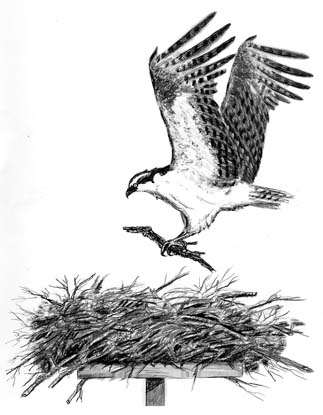
Dear Bird Folks,
On my vacation last week I spent hours watching Ospreys build a nest. It was amazing to watch these birds build such an intricate nest. My question is, why were the birds building their nest in August? Isn’t that kind of late in the breeding season for such a large bird of prey to be nesting?
-Jeff, Reston, VA
I’m With You Jeff,
I could spend my entire vacation watching Ospreys build a nest too. Let the rest of the family fight for blanket space on the beach or wade through the junk in the outlet stores. I’d much rather sneak off to some quiet location and observe nature. Watching birds build a nest is an ideal way to spend a summer’s afternoon. There is nothing I enjoy more than watching someone or something else work. I even tried to go to college to become a “Professional Observer” but the classes were all filled with DPW foremen.
It is so nice to be able to see Ospreys again. Thirty years ago there were so very few around. In some areas as much as 90% of the population had been wiped out. Pesticides caused most of the trouble, but many birds were victims of egg collectors or were shot by boneheads. There was, and perhaps still is, a small segment of our population who feel that humans are more entitled to fish than the Ospreys are.
Most birds, and humans for that matter, are able to eat a variety of foods, but Ospreys are totally fish dependent. They eat fish for breakfast, fish for dinner, fish for dessert. In fact, 99% of their diet is fish, with the other 1% being Lasagna, which is getting harder to find in the wild. It is their need to eat fish that got them into trouble. We all know the drill. Before it was banned the nasty pesticide DDT found its way into the water, the fish drank the water, and the Osprey ate the fish. DDT didn’t necessarily kill the Ospreys, but it caused the female’s to lay thin shelled eggs. The eggshells were so thin that they often broke, resulting in more omelets than baby chicks.
That was back in the 1970s. The ’70s were dark times for many things, but it was especially bad for Ospreys, water quality and, of course, fashion. The good news is we no longer use DDT, collectors have switched from eggs to Beanie Babies, the Ospreys population has recovered and leisure suites have been banned in most communities. Times are good.
You were right to question why those birds were building a nest so late in the year. Many of the Ospreys that nest in the north spend their winters in South America. A pair could not build a nest in August and still have enough time to set on eggs, raise the chicks, teach them about life and be ready for the long migration. So why were the birds you saw building a nest in August? They were simply setting up “housekeeping.” That’s right, they were playing house. Come on, weÕve all done it, there’s nothing to be ashamed of.
Unlike songbirds that are able to breed within their first year, large birds of prey take several years to reach maturity. Young Ospreys donÕt breed their first year, so instead they remain on their wintering grounds in South America. They figure there is no sense in making that long dangerous flight north if there isn’t going to be any mating at the end of it all. I’d have to agree with them on that.
By the time they have reached two years of age the young Ospreys start getting bored with the good life in South America and return to their old neighborhoods up north. They are still too young to breed, but they are allowed to date. While most of the relationships are platonic, some birds do pair-up and pick out nesting sites and a few actually start to build. However, those nests are not completed. It takes several months for the birds to get all the permits approved by the town, plus the endless inspections and let’s not forget about the new septic. Good luck to them with that.
The birds that you saw Jeff were most likely two year old birds that were simply going through the motions of building a nest, aka housekeeping. That nest won’t be completed until they return as mature adults next May. If you get a chance, you should go back and watch the the birds in action. Besides large sticks, Ospreys add an odd assortment of junk to their nest. The junk can include rope, plastic bags, fishing gear and one nest even contained the remains of a leisure suit, finally a good use for them.